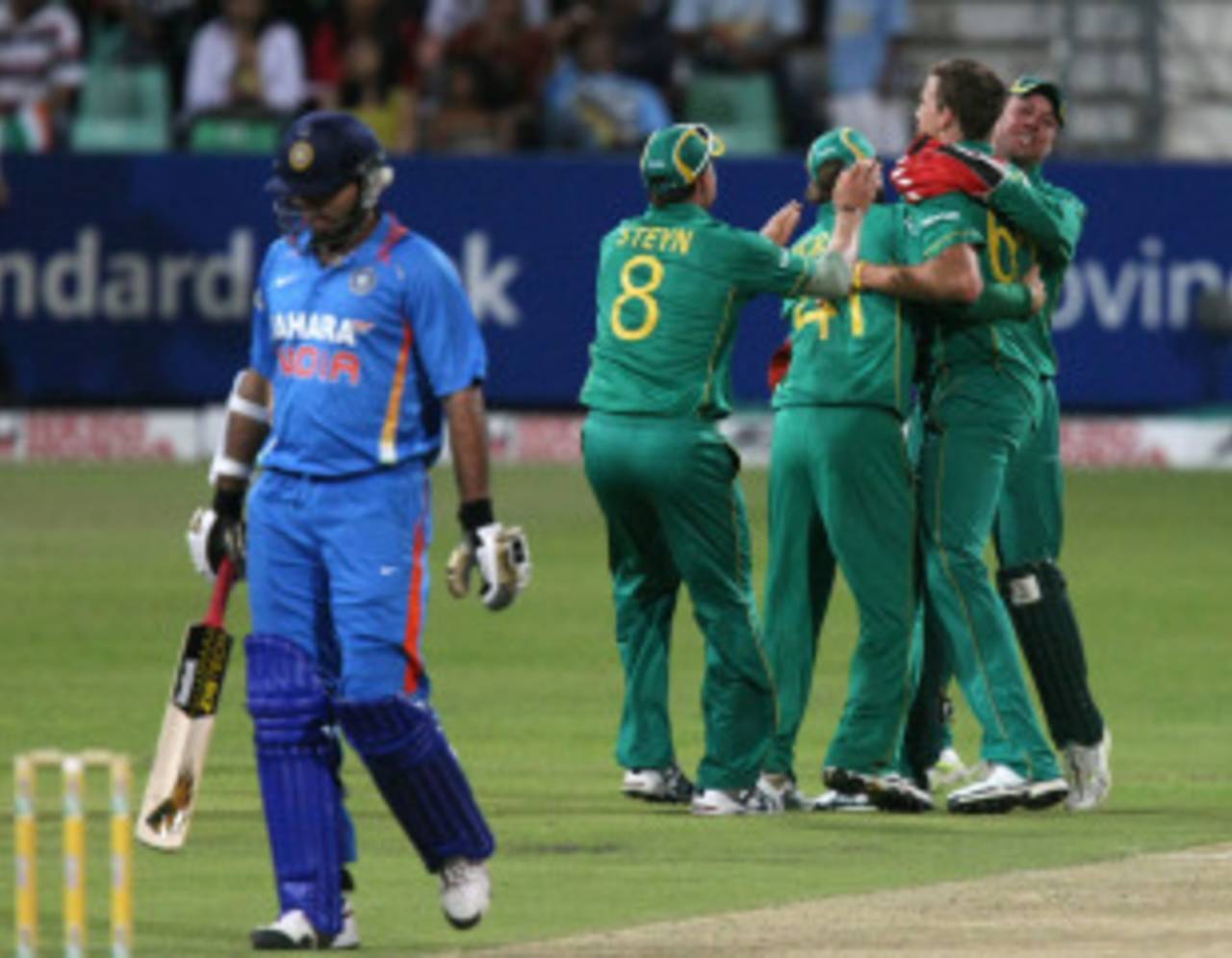India's short-ball woes continue
While the Indian bowlers and fielders had a largely forgettable day, India's fortunes in this series rest on whether their batsmen can turn things around against the short ball
Sidharth Monga at Kingsmead
13-Jan-2011

The Indian batsmen once again looked suspect against the short ball • Getty Images
India's start to this ODI series has been painfully similar to many of their earlier outings in South Africa. In the 2003 World Cup, they were bundled out for 125 in their first game against a top-level team. Their 2006-07 tour got underway at the same venue, Durban, after the washout in Johannesburg, in almost identical fashion: lose the toss, concede 250-plus, and get bowled out for a paltry total to lose by more than 100 runs. In their first ODI this time around, they have managed 18 more than they did in the first innings of the Test series. Their bowling, too, looked listless as it had on their various previous starts.
After the defeat, MS Dhoni didn't waste too much time pondering over the reasons behind the slow starts. "I think we could have done better," Dhoni said. "When you play with four bowlers and part-timers, you have that pressure that if one bowler has a bad day, you have to put the rest of the overs on the part-timers. Fortunately in this game, the part-timers did a good job; they brought us back into the game, but still chasing close to 280-285 in Durban is quite a difficult task."
The bowler with the bad day today was Ashish Nehra, who looked like a man who had just got off the plane and come on to bowl. Pace, movement, sting, were all absent, and the figures of 1 for 61 in six overs were well-earned. Dhoni, though, knows that he doesn't have too many choices apart from the bowlers that are on the tour, plus the injured Praveen Kumar.
"The most important thing is, these are three or four fast bowlers that we have got," Dhoni said. "So whatever the conditions may be, we have to back them to do well. So we don't have too many options right now. We don't see too many options when it comes to fast-bowling department. Right now I am not bothered about whether they have any match practice or not, we need these four or five fast bowlers to be fit going into the World Cup."
While the bowling was a big letdown today, and India lost the game in the field, it is arguable that it can improve on short notice. What will need more work are the limited-overs batsmen, who still remain suspect on pitches with bounce. That is a shortcoming that makes coming back from this setback difficult. It will take either a lot of improvement from the batsmen or real flat pitches for them to make this more like the 2003 World Cup and the recent Test series, as opposed to the 4-0 defeat they were at the wrong end of in 2006-07.
The pitch didn't change too much in the evening; not as much as it does usually. It was just bounce, with zero swing, and not much seam movement. M Vijay played back to a full ball. Rohit Sharma was worked over by short bowling from Morne Morkel, who got the ball to straighten just a touch. The difference between Moses Mabhida and Kingsmead couldn't have been starker. Rohit's bowling made sure India didn't miss Yusuf Pathan in the field, but it was his being a specialist batsman that had made India play him on what they expected to be a tough track. Yuvraj Singh fended at a short ball without getting behind the line. By the time Suresh Raina came out the game was over.
However, it doesn't look likely that India are going to include a fifth bowler or even a bowling allrounder like R Ashwin. "People may say if six batsmen don't do the job, the seventh won't or may not do the job," Dhoni said. "You have to see if four bowlers can do the job, or if four can't do the job, how and why will the fifth do that job? I think it's debatable. It always depends on what kind of team you play with. If you see the history of Indian cricket, we have always been comfortable playing with four bowlers. One of the major reasons being we don't have a seaming allrounder."
Still there was a positive on a day that India will like to forget as quickly as they can, in Virat Kolhi, who with every game is giving the team management more and more reasons to have him in the starting XI in Mirpur on February 19. He is still unlikely to make it if the others are all fit, but at least the team management knows there is a solid back-up who is in good form and eager to take the chance.
In the absence of Virender Sehwag and Gautam Gambhir, the team once again looks overly reliant on Sachin Tendulkar, who didn't look in discomfort until a risky shot didn't come off. Tendulkar might need more than just Kohli's support if India are to turn this series around.
Sidharth Monga is an assistant editor at ESPNcricinfo